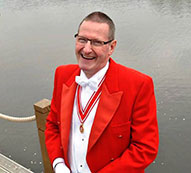Town Crier to the fine city of Norwich
In 2010 Norwich City Council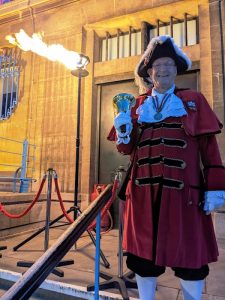 advertised for a deputy town crier to succeed David Bullock when he retired. Having recently qualified as a professional toastmaster, I decided to apply and was asked to attend an interview with David and the City Clerk. David had prepared a cry that I was asked to make from the steps of City Hall. 24 hours later I received a ‘phone call offering me the post as I had been chosen as the successful candidate.
advertised for a deputy town crier to succeed David Bullock when he retired. Having recently qualified as a professional toastmaster, I decided to apply and was asked to attend an interview with David and the City Clerk. David had prepared a cry that I was asked to make from the steps of City Hall. 24 hours later I received a ‘phone call offering me the post as I had been chosen as the successful candidate.
I designed and had my livery made by a professional theatrical costume maker in Dereham, and was proud to wear it alongside David for the first time at the appointment of the newly elected Mayor.
During the next few years I fulfilled a number of engagements deputising for David at civic events. These included the Mayor making and Freemen of the City ceremonies, and leading the annual Lord Mayor’s street procession. I was also asked by various commercial companies to advertise their business on the streets of Norwich. More recently I was asked to proclaim the 150 services that Norwich council provide. Love the looks on peoples faces! https://www.bbc.co.uk/news/av/uk-england-norfolk-43840185/town-crier-explains-what-local-councils-actually-do
In January 2017, after serving the city for over 30 years David finally retired and, at a handing over ceremony in the City Hall, I was officially appointed as the Norwich City Crier.
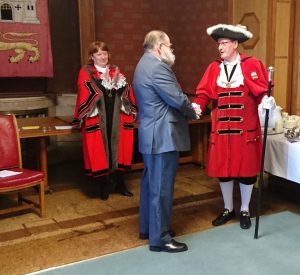
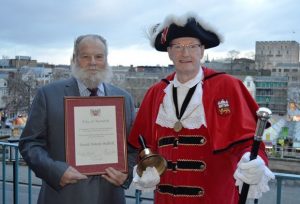 I offer local companies and individuals the opportunity to have their business or special event proclaimed to the public at large. This can be on the streets of Norwich or other towns and cities across the region. I can also attend functions to accompany the Lord Mayor of Norwich, the opening of a new shop or perhaps the local village fete.
I offer local companies and individuals the opportunity to have their business or special event proclaimed to the public at large. This can be on the streets of Norwich or other towns and cities across the region. I can also attend functions to accompany the Lord Mayor of Norwich, the opening of a new shop or perhaps the local village fete.
The role of the town crier is steeped in history. In this current technological age it may seem an outdated way of advertising but it has worked very well for companies who have engaged my services. These include Archant, Tesco, House of Fraser, The Assembly House, Home Instead Senior Care, Maids Head Hotel, Norfolk Hospice, Celebrate Norwich & Norfolk, Lloyd’s Bank, Specsavers, Hotter shoes and the Whittard tea company.
When a number of town criers are gathered together in one place it called a ‘bellow’ of criers. This was the case in April 2017 when I invited town criers from Norfolk to join me in Norwich to celebrate my appointment.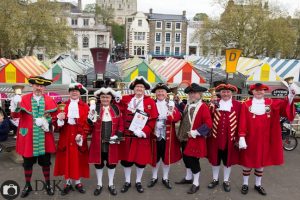
The sight and sound of the town crier attracts the attention of citizens and visitors alike who stop to listen to the proclamation. So if you have an event or function where the colourful and ‘noisy’ appearance of the town crier would make an impact please contact me to discuss your requirements and appropriate fee. I am a member of the Ancient and Honourable Guild of Town Criers.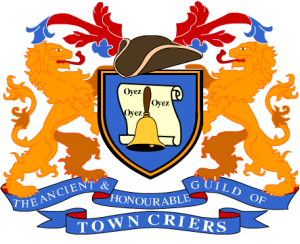
Great to be a part of the historic promotion to the premier league for NCFC in 2019.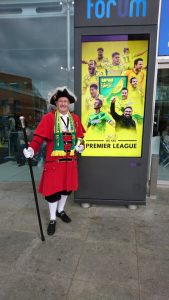
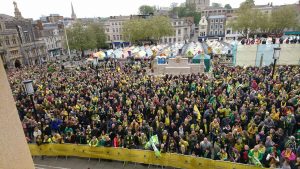
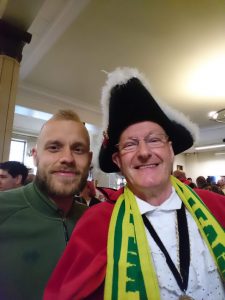
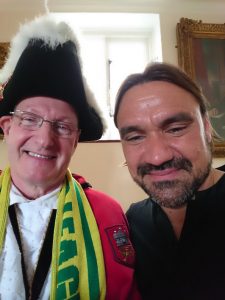
History of the Town Crier
Historically town criers – or Bellmen as they were sometimes called – were the original newsmen. The first town criers were the Spartan Runners in the early Greek Empire and as the Roman Conquest spread through Europe the position increased in importance until it became a position of the court. Town criers were particularly important when most of the population was illiterate. Though their origin is much older, the position was formalised after the Norman Conquest of 1066.
As England colonised the world, the position of the town crier spread with it. Before people could read, town criers brought the news to the people, and served as spokesmen for the King. Town criers were protected by law. “Don’t shoot the messenger” was a very real command; anything that was done to a town crier was deemed to be done to the King and was therefore a treasonable offence. Usually people of standing in the community were chosen as criers, for they had to be able to write and read the official proclamations. Often they were a husband and wife team with the wife ringing the large hand bell and the husband doing the shouting. The Town crier would read a proclamation, usually at the door of the local inn, then nail it to the doorpost of the inn. The tradition has resulted in the expression “posting a notice” and the naming of newspapers as “The Post”.
Each town crier is officially appointed by the Mayor. The style of uniforms is authentic and date back to the 17th Century. The Town crier’s robes are similar to those of the mayor, and uniforms are usually designed, incorporating the colours of the Crier’s town. The ceremonial tricorne hat is adorned with curling feathers, a traditional representation of the quills used by earlier town criers to write their proclamations.
Announcements are always preceded by the traditional “Oyez! Oyez! Oyez!” (which is “listen” in French) and conclude with “God save the King”.
Town Criers and bellmen were largely phased out in the early 20th Century – in part because of the growth of local newspapers and literacy rates but the position has been revived by councils all over Britain since the 1970’s. When ‘The Ancient and Honourable Guild of Town Criers was founded in 1978 it had about 20 members. It now has more than 130 and continues to grow.
.
